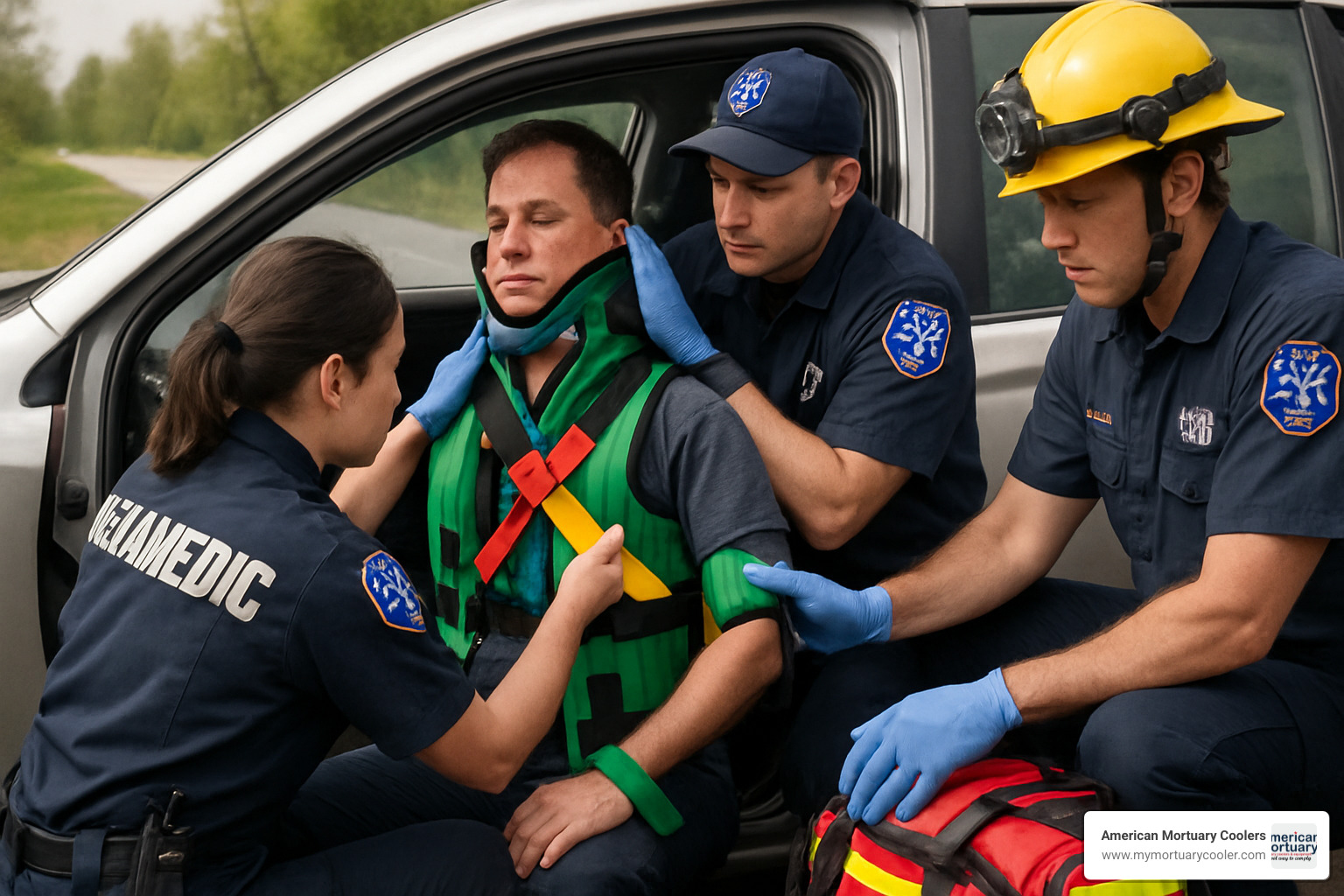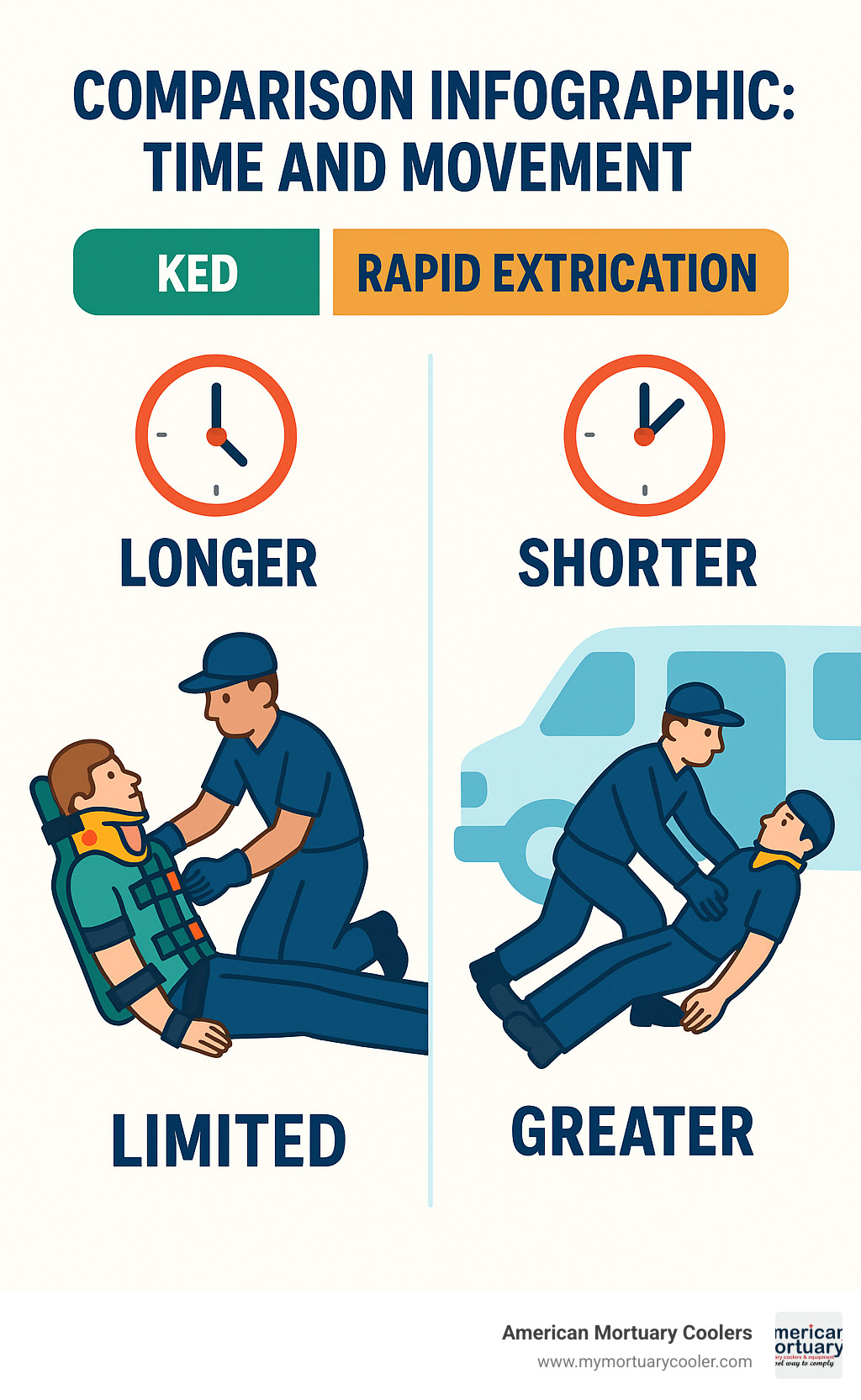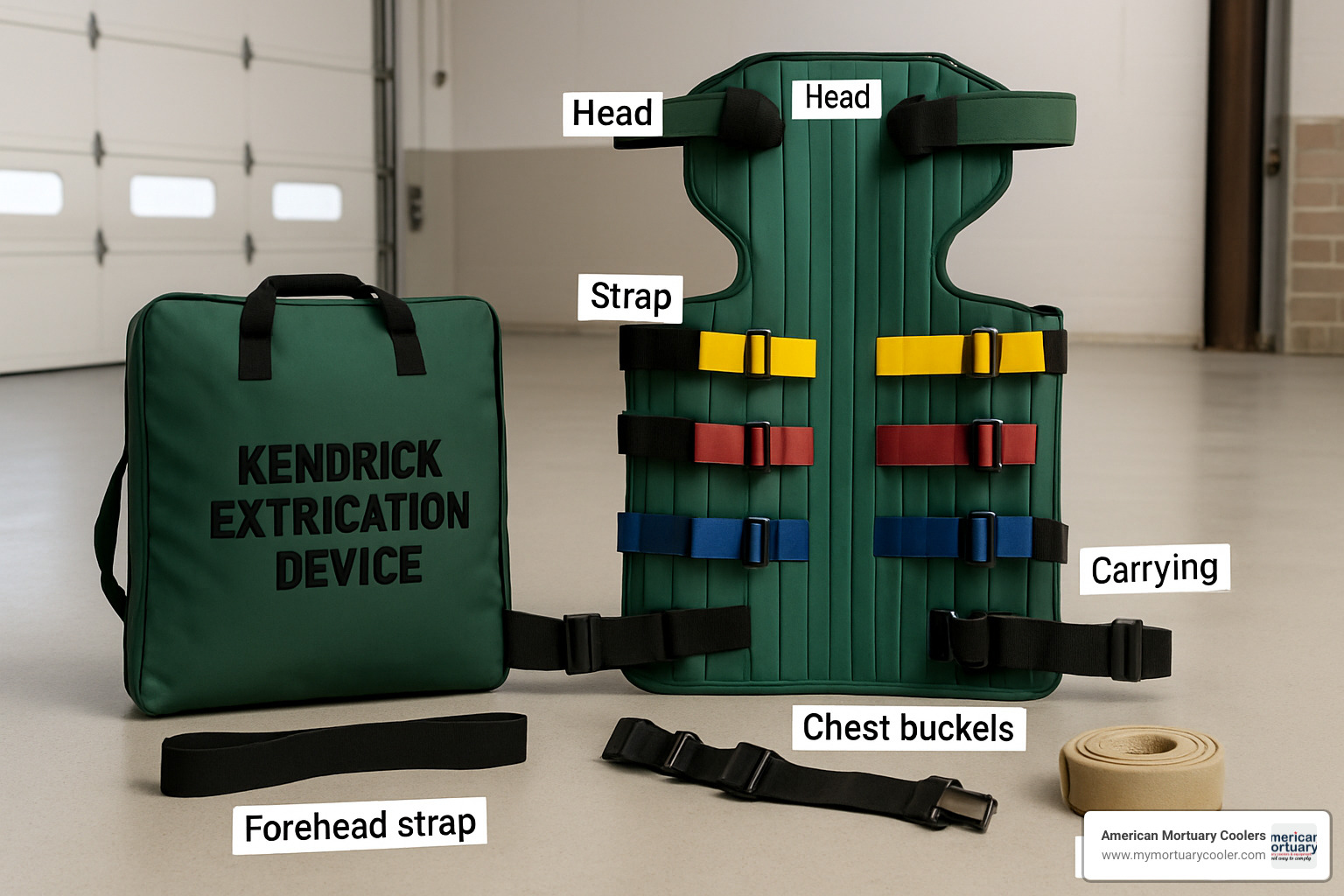
Medical Ked Terms Demystified
Understanding the Medical KED Device
A medical ked is a Kendrick Extrication Device used by emergency responders to safely immobilize and extract patients from confined spaces like vehicle crashes. Here's what you need to know:
Primary Purpose:
- Immobilizes head, neck, and torso during patient extrication
- Prevents further spinal injury in suspected trauma cases
- Allows safe removal from tight spaces where backboards won't fit
Key Specifications:
- Load limit: 500-550 lbs depending on manufacturer
- Weight: 8-9 lbs
- Applied by minimum of two trained operators
- Compatible with adult, pediatric, and pregnant patients
When It's Used:
- Motor vehicle accidents with seated patients
- Confined space rescues
- Situations where direct backboard transfer would worsen injury
The medical ked was originally developed in 1978 for race car drivers and received its U.S. patent in 1980. Research shows that while the device takes significantly longer to apply than rapid extrication (6.63 minutes vs 0.74 minutes), it does reduce lateral cervical movement during patient transfer.
However, the clinical evidence supporting its use remains limited, and current EMS protocols emphasize that scene safety and patient stability should always guide the decision to use a medical ked versus rapid extrication techniques.
I'm Mortuary Cooler, and as a national supplier of mortuary and medical equipment, I've worked extensively with emergency response devices including the medical ked and related patient transport systems. My experience spans across providing reliable equipment solutions for funeral homes, EMS services, and medical facilities nationwide.
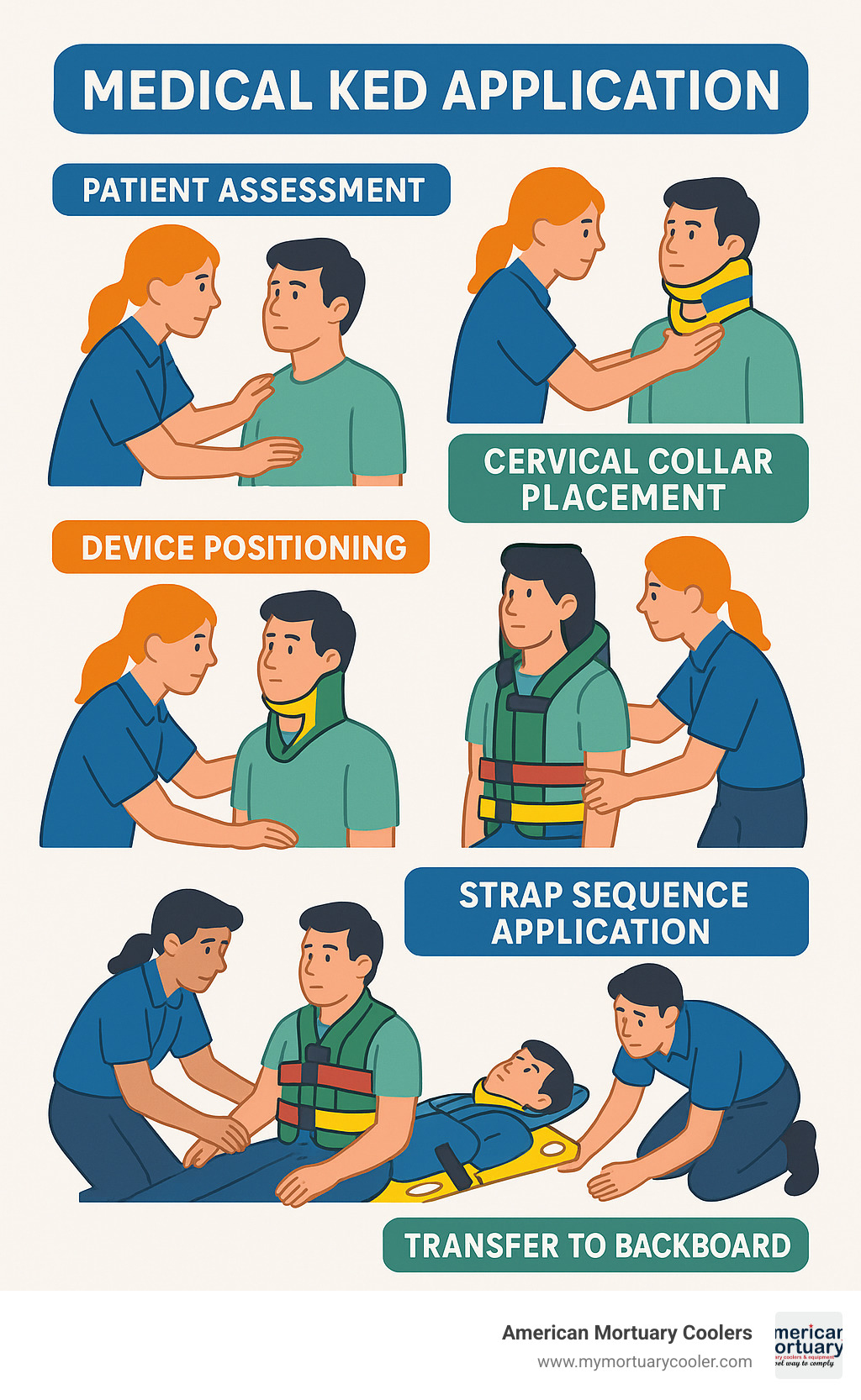
Find more about medical ked:
Why This Guide Matters
When you're facing a car accident or confined space rescue, split-second decisions can mean the difference between life and death. As someone who's spent years working with emergency response equipment, I've seen how the right knowledge can transform a chaotic scene into a controlled, life-saving operation.
The medical ked sits at the heart of one of emergency medicine's most critical debates: How do we balance thorough spinal protection with the urgent need to get patients to definitive care? This isn't just an academic question—it's a decision that paramedics, EMTs, and first responders face in real-world emergencies every single day.
Scene safety drives everything we do in emergency response. A beautiful, textbook application of a medical ked means nothing if the car catches fire or traffic creates additional hazards. But rushing through a rapid extrication without proper spinal precautions can turn a survivable injury into a lifetime of paralysis.
Here's what makes this guide different: we're not going to tell you that the medical ked is always right or always wrong. Instead, we'll give you the evidence-based facts you need to make informed decisions. Whether you're studying for your EMT certification, training your crew, or simply want to understand what happens during emergency calls, you'll walk away knowing exactly when this device saves lives—and when it doesn't.
The truth is, patient outcomes depend on understanding both the capabilities and limitations of every tool in your arsenal. That's exactly what we're here to help you master.
Understanding the Medical KED
Origin: Who Invented the Medical KED?
Picture this: it's 1978, and race car drivers are getting injured in crashes, but getting them out of those tight cockpits safely is nearly impossible. Enter Richard Kendrick, a paramedic who saw this problem and decided to do something about it.
Kendrick's brilliant solution was a wrap-around vest that could immobilize a person's spine while still allowing them to be extracted from confined spaces. His invention was so effective that it earned U.S. Patent 4,211,218 in 1980, and the medical ked quickly made its way from the racetrack to ambulances across America.
What started as a motorsport safety device became one of the most important tools in emergency medicine. Pretty amazing how innovation often comes from the most unexpected places, right?
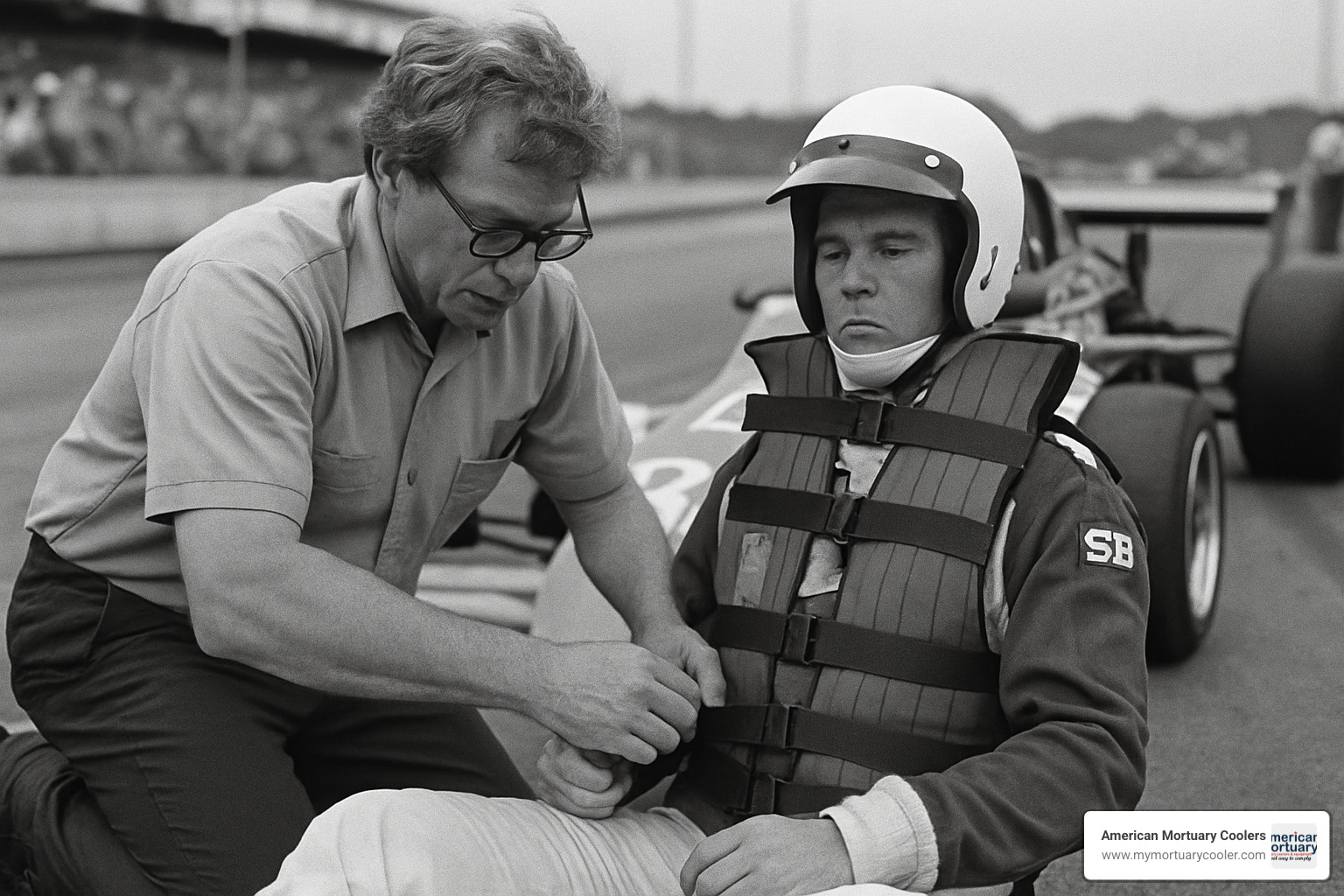
Primary Purpose of a Medical KED
The medical ked has one main job: keep the torso, head, and neck moving together as one unit. Think of it like creating a protective shell around the most vulnerable parts of someone's spine.
When EMTs arrive at a car accident, they can't just yank someone out of their seat—that could turn a manageable injury into permanent paralysis. The medical ked solves this problem by immobilizing the entire upper body before any movement happens.
The wrap-around design is what makes it special. Unlike a rigid backboard that won't fit in tight spaces, the medical ked can be slipped around a patient even when they're wedged into a crumpled car. It's flexible enough to get into confined spaces but rigid enough to protect the spine during the entire extraction process.
History of the Medical KED
The story behind the medical ked really shows how necessity drives innovation. Kendrick wasn't just an inventor—he was a paramedic who understood the real-world challenges of emergency medicine. He'd seen too many situations where traditional immobilization devices simply wouldn't work.
From those early days in 1978 motorsport to receiving his 1980 patent, Kendrick created something that would save countless lives. The device spread from race tracks to emergency rooms, becoming standard equipment on ambulances nationwide.
Today, decades after its invention, the medical ked remains largely unchanged from Kendrick's original design. Sometimes the first idea really is the best one.
Read scientific research on KED effectiveness
Anatomy of the Device: Key Features & Accessories
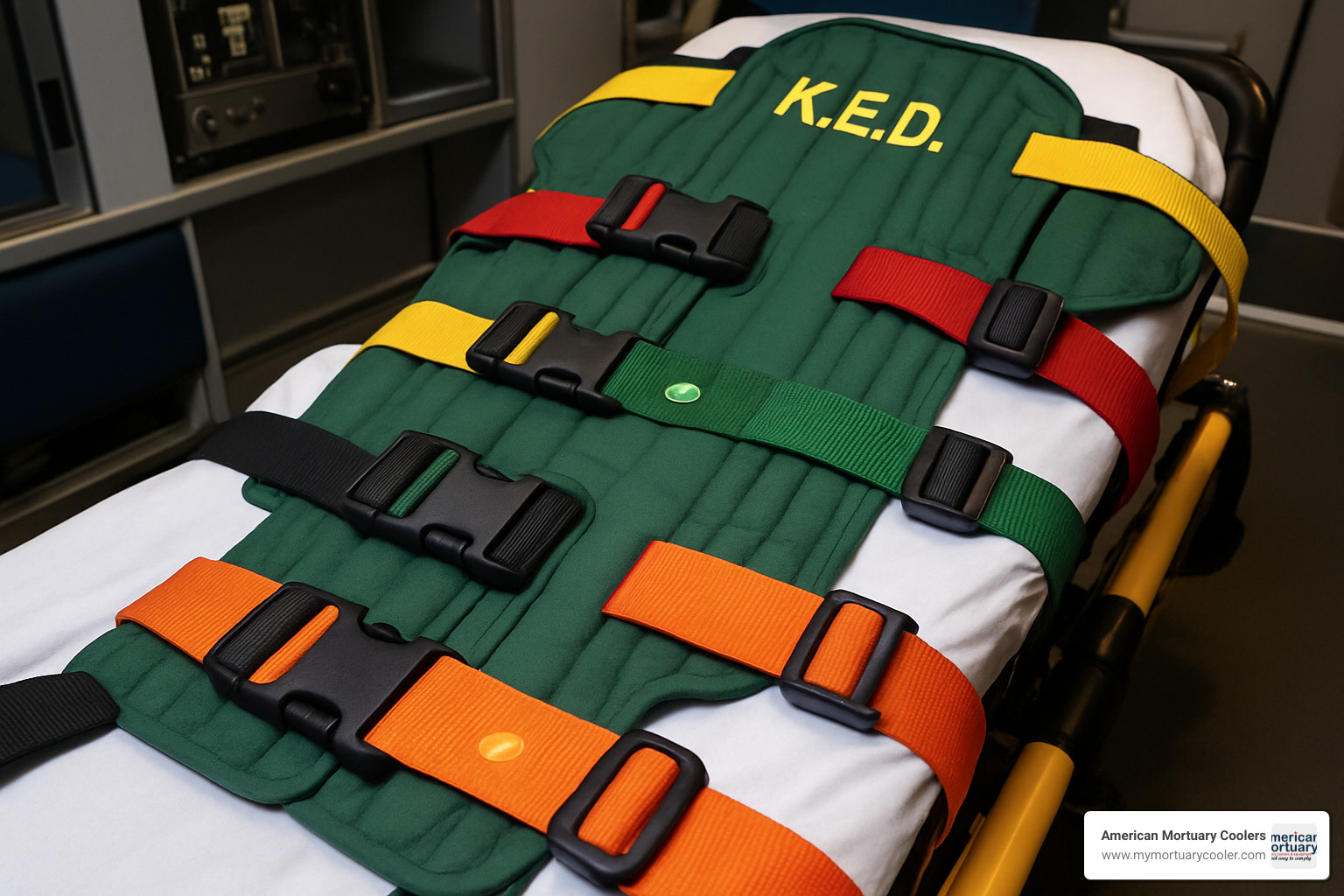
When you first look at a medical ked, you might think it looks like a complicated vest with lots of straps. But there's actually a smart design behind every component that makes it work so well in emergency situations.
The beauty of the KED lies in its balance of strength and flexibility. The vertical rigidity keeps your patient's spine protected, while the horizontal flexibility lets you wrap it around someone sitting in a cramped car seat. This isn't just clever engineering—it's what makes the difference between a successful rescue and a dangerous one.
Most devices can safely handle patients up to 500-550 pounds, depending on the manufacturer. They're also radiolucent, which means X-rays can pass right through them (except for the metal buckles), so your patient doesn't need to be removed for imaging at the hospital.
Core Components Explained
The torso panels are the backbone of the whole system. These semi-rigid panels create that crucial spinal support while still allowing you to maneuver around tight spaces. Think of them as protective armor that bends where it needs to.
Those color-coded straps and securing buckles aren't just pretty—they're lifesavers when you're working under pressure. The color coding helps prevent mistakes when every second counts. You'll typically find three torso straps, two leg straps, and two head straps, each designed for a specific part of the immobilization process.
The built-in handles might seem like a small detail, but they're essential for controlled patient movement. These handles distribute weight evenly and give you secure grip points when transferring your patient to a backboard.
Head support components include adjustable pads that cradle the head and maintain proper cervical alignment. The leg straps complete the package by securing the lower body and preventing any shifting during the transfer process.
Optional Add-Ons & Replacement Parts
Like any piece of medical equipment that sees regular use, your medical ked will need some TLC over time. Replacement strap kits are essential—those straps take a beating, and worn straps can compromise the entire device's effectiveness.
A good carrying case keeps your KED protected and ready for rapid deployment. Trust me, fumbling with tangled straps during an emergency is the last thing you want to deal with.
For pediatric patients, the adjustable neck roll (sometimes called "Adjust-a-Pad") improves comfort and airway alignment. Children have different proportions than adults, and this accessory helps accommodate those differences safely.
Here's something cool: some KEDs can be flipped and used in hip-pelvic splint mode. It's like getting two devices in one, which is always handy when storage space is limited.
Don't forget about cleaning and maintenance kits. These devices see some rough conditions, and proper hygiene isn't just good practice—it's essential for patient safety and device longevity.
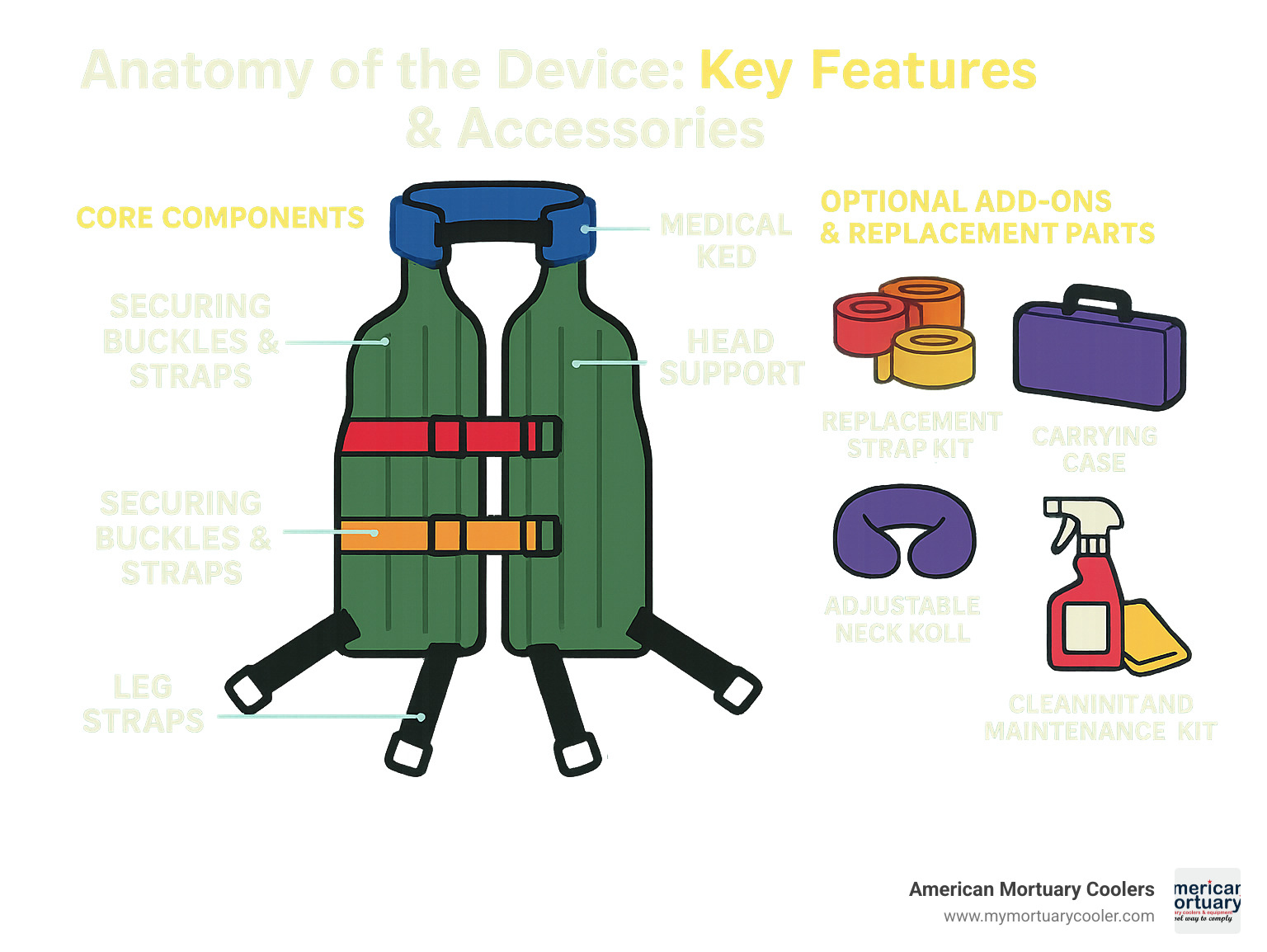
Find more info about KED accessories here.
How to Apply a Medical KED: Step-by-Step
Getting a medical ked on a patient correctly isn't just about following steps—it's about doing it safely and efficiently when someone's life might depend on it. Let's walk through this together, because proper application can make all the difference.
Before you even touch the device, you need to get your basics right. Manual in-line stabilization is your first priority—someone needs to hold that patient's head and neck in a neutral position throughout the entire process. Don't let go until the device is fully secured. Next comes the cervical collar—always apply a properly sized one before the KED goes on. And here's something that's easy to forget in the heat of the moment: check circulation, motor function, and sensory response in all extremities before you start. You'll need to do this again during and after application too.
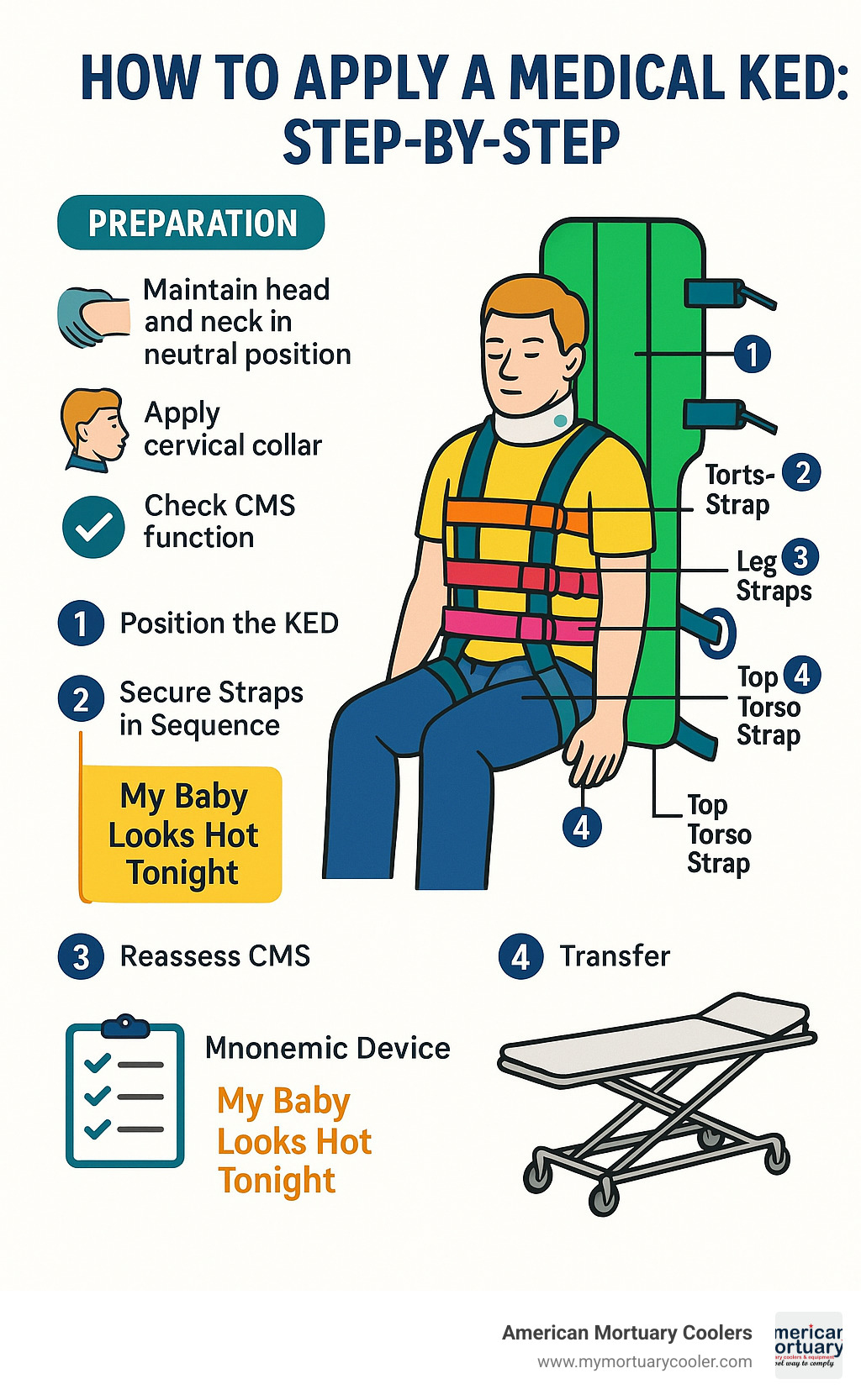
Adult Application Procedure
Now for the actual application. Start by positioning the KED behind your patient's back while they're still seated—slide it down carefully with all straps unfastened and out of the way.
Here's where the magic happens with the strap sequence. There's a specific order that works best, and experienced EMTs use the mnemonic "My Baby Looks Hot Tonight" to remember it. The middle torso strap goes first, followed by the bottom torso strap. Next come the leg straps—cross them if there's no groin injury. The head straps are fourth, and make sure to pad any gap between the patient's head and the device. Finally, apply the top torso strap just before you're ready to move the patient.
Don't rush through your CMS checks—do them before moving, after securing the straps, and again after transfer. When it's time to move, treat the patient and medical ked as one solid unit. Transfer them together onto a long backboard, then to your stretcher.
Pediatric & Pregnant Modifications for a Medical KED
Kids and pregnant patients need special attention. With pediatric patients, you'll often need to pad under the back of the head (the occiput) to keep their airway in a neutral position—children have proportionally bigger heads than adults. Be extra careful not to cover their chest and abdomen where you need to monitor breathing.
Pregnant patients present their own challenges. You might need to loosen or skip the leg straps entirely if they're interfering with circulation or blood flow to the uterus. Keep a close eye on their airway and breathing throughout the process.
Here's a golden rule for both groups: never force a patient's head into position. If you meet resistance or the patient reports pain, adjust your approach.
Rapid Extrication vs Medical KED
Sometimes you'll face a tough choice: take the time for a medical ked or go with rapid extrication? The numbers tell an interesting story. Research shows that using a KED takes an average of 6.63 minutes compared to just 0.74 minutes for rapid extrication. That's a significant difference when every second counts.
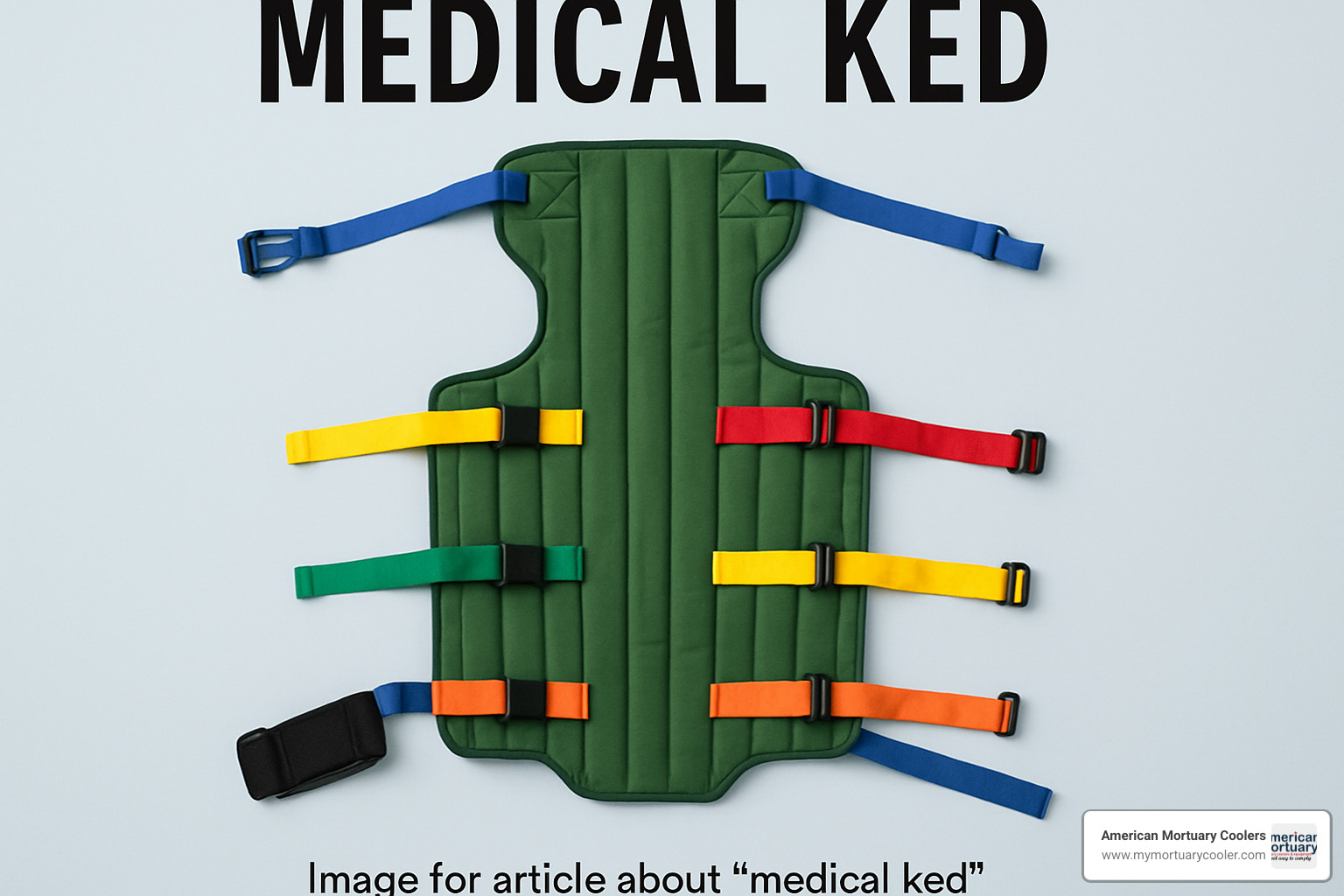
But here's the trade-off: the medical ked reduces head movement to about 16.9 degrees, while rapid extrication can result in 24.1 to 30.8 degrees of cervical movement. Patient comfort remains similar between both techniques.
So when do you choose which? Use the medical ked when your patient is stable, trapped but not in immediate danger, and you suspect spinal injury. Go with rapid extrication when the scene is unsafe, the patient is unstable, or time is absolutely critical.
The decision comes down to balancing spinal protection against scene safety and patient stability. A medical ked might protect the spine better, but if the scene is dangerous or the patient is deteriorating rapidly, getting them out fast becomes the priority.
For more detailed research on this comparison, check out this scientific study on KED effectiveness.
Benefits, Limitations & Evidence
Let's be honest about what the medical ked can and can't do. Like any medical device, it has its strengths and weaknesses, and the evidence tells an interesting story.
Benefits
The good news first: research shows that a medical ked genuinely reduces cervical motion during patient extrication. Studies confirm less lateral head movement compared to rapid extrication techniques—which is exactly what the device was designed to do.
The versatility is impressive too. Whether you're dealing with adults, children, or pregnant patients, the KED adapts well with proper modifications. And when you're facing a confined space rescue where a long spine board simply won't fit, the KED becomes invaluable.
What might surprise you is that patient comfort remains neutral between KED application and rapid extrication. Patients don't report significantly more pain or discomfort with either method, which debunks the myth that the KED is somehow more uncomfortable.
Limitations
Here's where reality sets in. The biggest limitation is prolonged scene time—we're talking an average of 6.63 minutes versus 0.74 minutes for rapid extrication. In a dangerous environment, those extra minutes can put everyone at risk.
Obese patient considerations add another layer of complexity. Research suggests the KED may actually allow greater cervical movement in larger patients, and the physical challenges of application increase significantly.
The device maintains hemodynamic stability well, but that's only helpful if your patient is stable to begin with. For critically injured patients, the time spent applying a KED might be time they don't have.
Contraindications
Some situations are clear-cut: don't use a medical ked in an unsafe scene where fire, traffic, or violence threatens everyone involved. Penetrating trauma patients often need immediate surgical intervention, not prolonged field immobilization.
Cardiac arrest or severely compromised airways require rapid removal—period. The KED simply isn't appropriate when seconds matter more than spinal precautions.
Evidence and Controversy
Here's the uncomfortable truth: there's no conclusive evidence that KED use improves long-term neurological outcomes. The scientific research on spinal precautions reveals an ongoing debate about whether extensive spinal immobilization actually helps patients in the long run.
Current EMS guidelines increasingly favor patient safety and scene assessment over automatic spinal immobilization. The evidence suggests that getting unstable patients to definitive care quickly often trumps perfect spinal immobilization in the field.
The research shows no significant difference in patient-reported pain between methods, which challenges some long-held assumptions about comfort and effectiveness.
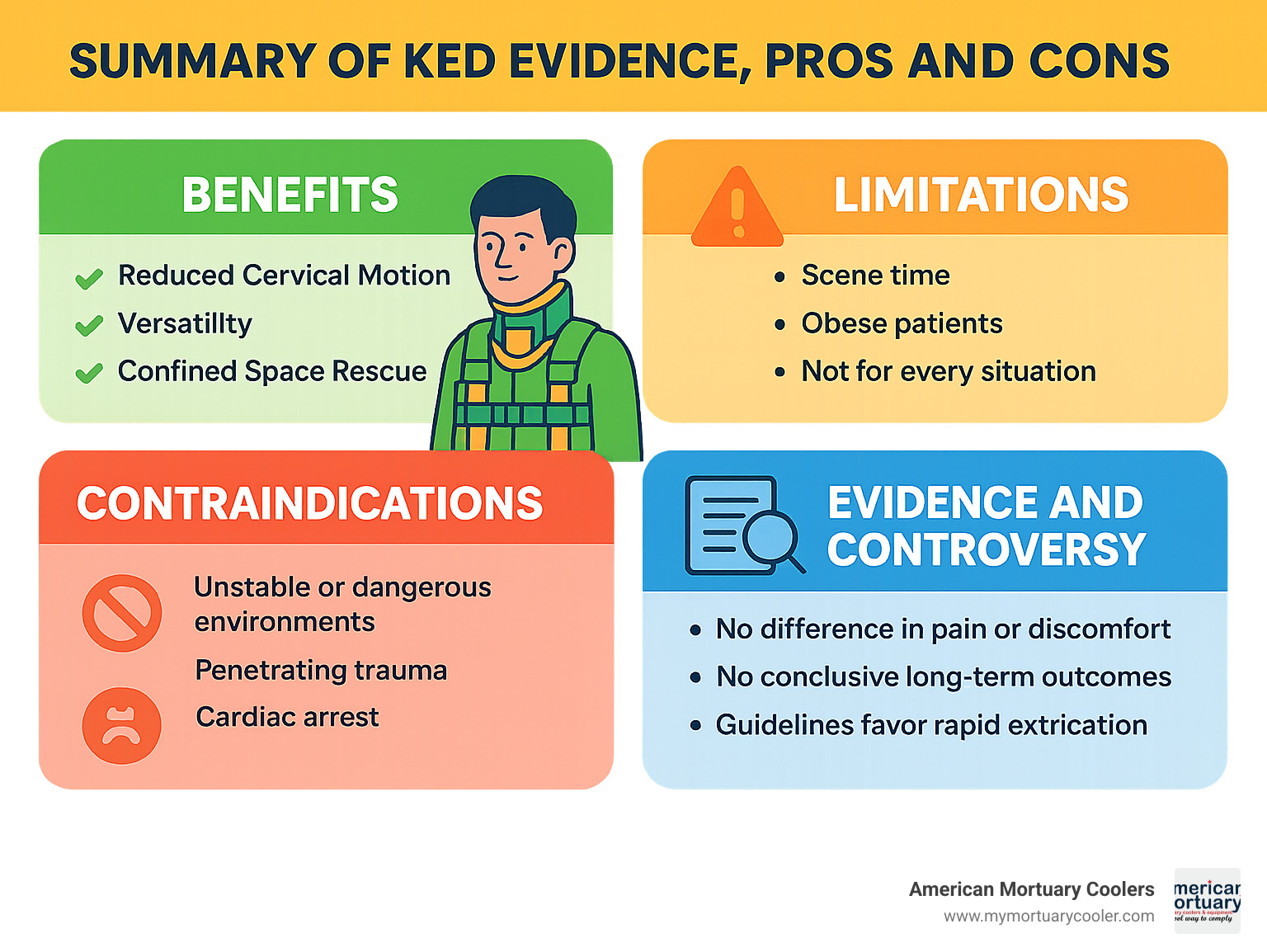
The bottom line? The medical ked is a valuable tool when used appropriately, but it's not a magic solution. Good clinical judgment about when to use it—and when not to—makes all the difference in patient outcomes.
Training, Guidelines & Documentation
Learning to use a medical ked properly isn't something you pick up in an afternoon. It takes dedicated training, ongoing practice, and careful attention to the evolving guidelines that shape how we approach spinal immobilization in emergency medicine.
Who's qualified to apply a KED? Only trained EMTs, paramedics, or qualified emergency responders should handle this device. It's not a piece of equipment you want amateurs fumbling with when someone's spine is on the line. The application requires a minimum of two operators—though having more hands available often makes the process smoother and safer for everyone involved.
The continuing education component can't be overstated. Regular practice sessions help responders stay sharp on the strap sequence, master pediatric modifications, and work through realistic scenario-based drills. Muscle memory matters when you're working under pressure at 2 AM on a rainy highway.
National and State Guidelines
Here's where things get interesting—and sometimes confusing. Many states require the medical ked on ambulances as standard equipment, so you'll want to check your local EMS checklists to see what's mandated in your area.
The National Association of EMS Physicians (NAEMSP) and other professional bodies have evolved their stance over the years. Rather than pushing automatic KED use for every seated trauma patient, current guidelines emphasize something more nuanced: scene safety and patient condition should always guide your decision.
This shift reflects growing evidence that sometimes rapid extrication—even with slightly more spinal movement—is the safer choice when you're dealing with unstable patients or dangerous environments.
Documentation
Proper documentation isn't just bureaucratic box-checking—it's about creating a clear medical record that protects both the patient and your team. Document CMS findings (circulation, motor, sensory) at three critical points: before application, during the process, and after transfer. This creates a timeline that shows how the patient responded to the intervention.
Don't forget the technical details either. Record the device serial number, application time, and the names of all operators involved. If you made any modifications—like pediatric padding or omitted straps for a pregnant patient—note those decisions and your reasoning.
After the call, follow your agency's cleaning and decontamination protocols. These devices get reused, and proper maintenance ensures they'll work correctly for the next patient who needs them.
Read more about KED EMS training and best practices.
Common Myths About the Medical KED
Let's clear up some persistent misconceptions that still float around EMS circles.
"The KED is always necessary" might be the most dangerous myth out there. Scene safety trumps everything else. If you're dealing with a car fire, unstable vehicle, or violent scene, rapid extrication becomes the priority—even if it means more spinal movement.
"One-strap fits all" couldn't be further from the truth. The strap sequence and adjustment must be customized to each patient's size, condition, and specific situation. A 250-pound construction worker needs different considerations than a pregnant woman or elderly patient with arthritis.
Perhaps most importantly, "The KED is proven to prevent paralysis" oversells what the research actually shows. The evidence is mixed at best. What we do know is that the medical ked minimizes movement during controlled extrication—but whether that translates to better long-term outcomes remains an open question in emergency medicine.
Frequently Asked Questions about Medical KED Devices
Let's tackle the most common questions we hear about medical ked devices. As someone who's worked with emergency equipment for years, I know these are the practical concerns that keep coming up in the field.
How heavy of a patient can a KED safely support?
Here's the straight answer: most medical ked devices can safely handle patients weighing 500 to 550 pounds, depending on which manufacturer you're dealing with. That's quite a range, so always check the specifications on your specific device before you need it in an emergency.
Some specialty extrication devices claim they can handle even more weight, but don't take chances. The load limit isn't just about the device breaking—it's about whether you and your partner can safely maneuver that much weight while maintaining proper spinal alignment.
You're not just supporting static weight. You're dealing with the dynamic forces of lifting, turning, and transferring a patient from a confined space to a backboard. That puts extra stress on both the device and your team.
When should rapid extrication override the use of a medical ked?
This is where clinical judgment really matters. Scene safety always comes first—no exceptions. If you're dealing with fire, risk of explosion, dangerous traffic, or any other immediate threat, get that patient out fast using rapid extrication techniques.
Patient condition is the other big factor. If someone has a compromised airway, trouble breathing, or is hemodynamically unstable, the extra 6 minutes it takes to apply a medical ked could cost them their life. Sometimes a little extra spinal movement is the lesser of two evils.
Don't forget about access issues either. If your patient is blocking access to other victims who need immediate care, rapid extrication might be the only ethical choice. It's tough, but sometimes you have to make these hard calls.
Does the KED stay on during X-ray or ALS procedures?
Yes, and this is actually one of the medical ked's best features! The device is radiolucent, which means X-rays can pass right through it. The only exception is those metal buckles—they'll show up on imaging, but they won't interfere with reading the important stuff.
This means your patient can go straight from the ambulance to the CT scanner or X-ray room without any delays. The emergency department staff can start advanced life support procedures, get IV access, and do their initial workup all while the patient stays safely immobilized.
It's a huge advantage over some other immobilization methods that have to be removed before imaging. Every minute counts in trauma care, and the medical ked keeps things moving smoothly through the entire chain of care.
Conclusion
When it comes to patient safety, every decision matters. The medical ked represents decades of innovation in emergency medicine—from Richard Kendrick's race car solution in 1978 to today's EMS protocols. Understanding when and how to use this device can literally make the difference between life and paralysis.
The evidence is clear: while a medical ked takes longer to apply than rapid extrication, it significantly reduces dangerous spinal movement during patient transfer. But remember—scene safety always comes first. No device is worth risking your life or your patient's life in an unsafe environment.
Whether you're securing the middle-bottom-legs-head-top strap sequence or making split-second decisions about rapid extrication, your training and judgment are what truly save lives. The medical ked is simply one tool in your arsenal—a good one, but only when used appropriately.
At American Mortuary Coolers, we've spent years supporting emergency responders and funeral professionals across all 48 contiguous states. From our Tennessee headquarters, we've seen how the right equipment—properly maintained and expertly applied—makes all the difference. Whether you're serving communities in busy cities or rural areas, having reliable extrication gear you can trust is essential.
Safe extrication saves lives. It's that simple. The medical ked has earned its place on ambulances nationwide because it works—when applied correctly, by trained professionals, in the right circumstances.
Need more information about medical transport equipment or extrication gear? We're here to help. Check out our detailed guide to medical supply equipment for comprehensive information on rescue and transport solutions.
Stay safe out there. Your patients are counting on your expertise, your training, and your good judgment. And remember—if you have questions about any aspect of emergency medical equipment, we're just a phone call away.
